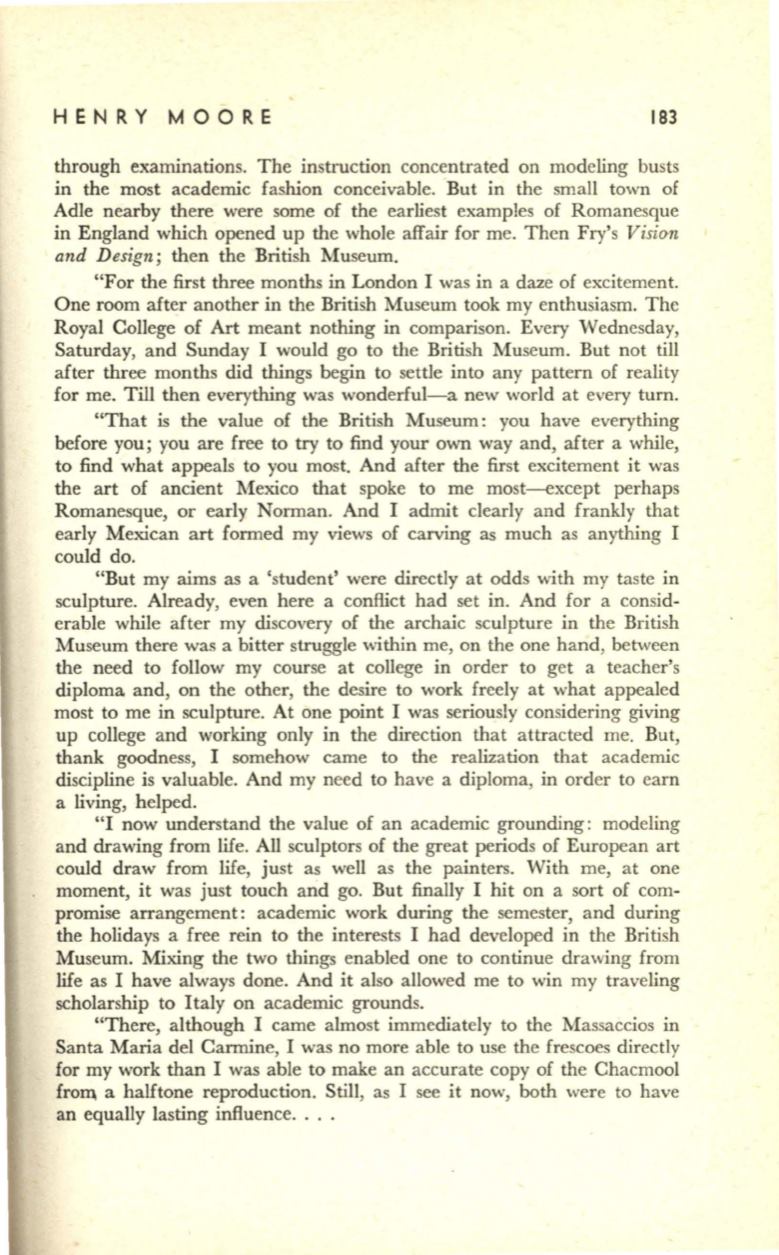
HENRY MOORE
183
through examinations. The instruction concentrated on modeling busts
in the most academic fashion conceivable. But in the small town of
Adle nearby there were some of the earliest examples of Romanesque
in England which opened up the whole affair for me. Then Fry's
Visio-n
and Design;
then the British Museum.
"For the first three months in London I was in a daze of excitement.
One room after another in the British Museum took my enthusiasm. The
Royal College of Art meant nothing in comparison. Every Wednesday,
Saturday, and Sunday I would go to the British Museum. But not till
after three months did things begin to settle into any pattern of reality
for me. Till then everything was wonderful-a new world at every turn.
"That is the value of the British Museum: you have everything
before you; you are free to try to find your own way and, after a while,
to find what appeals to you most. And after the first excitement it was
the art of ancient Mexico that spoke to me most--except perhaps
Romanesque, or early Norman. And I admit clearly and frankly that
early Mexican art formed my views of carving as much as anything I
could do.
"But my aims as a 'student' were directly at odds with my taste in
sculpture. Already, even here a conflict had set in. And for a consid–
erable while after my discovery of the archaic sculpture in the British
Museum there was a bitter struggle within me, on the one hand, between
the need to follow my course at college in order to get a teacher's
diploma and, on the other, the desire to work freely at what appealed
most to me in sculpture. At one point I was seriously considering giving
up college and working only in the direction that attracted me. But,
thank goodness, I somehow came to the realization that academic
discipline is valuable. And my need to have a diploma, in order to earn
a living, helped.
"I now understand the value of an academic grounding: modeling
and drawing from life. All sculptors of the great periods of European art
could draw from life, just as well as the painters. With me, at one
moment, it was just touch and go. But finally I hit on a sort of com–
promise arrangement: academic work during the semester, and during
the holidays a free rein to the interests I had developed in the British
Museum. Mixing the two things enabled one to continue drawing from
life as I have always done. And it also allowed me to win my traveling
scholarship to Italy on academic grounds.
"There, although I came almost immediately to the Massaccios in
Santa Maria del Carmine, I was no more able to use the frescoes directly
for my work than I was able to make an accurate copy of the Chacmool
fro~
a halftone reproduction. Still, as I see it now, both were to have
an equally lasting influence. . . .


